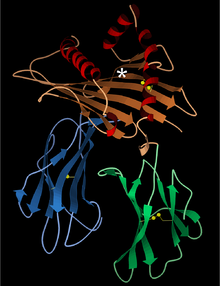Pamela Bjorkman
Pamela J. Björkman | |
|---|---|
 | |
| Born | 1956 |
| Alma mater | University of Oregon (B.A., 1978) Harvard University (Ph.D, 1984) |
| Scientific career | |
| Fields | Biochemistry Biological Engineering Microbiology Immunology |
| Institutions | California Institute of Technology UCLA Howard Hughes Medical Institute |
| Academic advisors | Don Wiley |
Pamela Jane Bjorkman NAS, AAAS (also spelled Pamela J. Björkman born 1956[1] in Portland, Oregon[2]) is an American biochemist. She is the David Baltimore Professor of Biology and Biological Engineering at the California Institute of Technology (Caltech),[3] Her research centers on the study of the three-dimensional structures of proteins related to Class I MHC, or Major Histocompatibility Complex, proteins of the immune system and proteins involved in the immune responses to viruses . Bjorkman is most well known as a pioneer in the field of structural biology.

Bjorkman earned a Bachelor of Arts degree in Chemistry at the University of Oregon, under the guidance of Hayes Griffith and Patricia Jost. She received her PhD in biochemistry at Harvard University in 1984, where she worked in the laboratory of Don Wiley. She stayed on in Wiley's lab in a postdoctoral position where she ultimately solved the first crystal structure of an MHC protein - the HLA-A2 human histocompatibility antigen. This work was published in 1987,[4] first at 3.5Å resolution (PDB entry 1HLA) and then refined at 2.6Å (PDB entry 3HLA).[5] Bjorkman continued her postdoctoral research at Stanford University in the laboratory of Mark Davis, studying the T-cell receptors that recognize antigens presented in the binding groove of MHC proteins. In 1989, she joined the Biology faculty at the California Institute of Technology as an assistant professor. She earned tenure as an associate professor in 1995 and was promoted to full professor in 1998. She was an HHMI investigator from 1989–2015.
The Bjorkman laboratory is interested in immune recognition of viral pathogens in order to develop improved therapeutics against rapidly-evolving viruses such as HIV-1. They use X-ray crystallography, cryo-electron microscopy, and biochemistry to study pathogen envelope glycoproteins and host immune response proteins. Using structural information and alternate antibody architectures, they are engineering antibody-based reagents with increased potency and breadth. They are also investigating the structural correlates of broad and potent antibody-mediated neutralization of HIV-1 to better understand what leads to naturally-occurring broad and potent antibodies. In related work, they use 3D imaging techniques such as electron tomography and fluorescent microscopy to investigate HIV/SIV infection in animal and human tissues.
Pamela Bjorkman's Erdős number is two, based on publication of a structural and mathematical analysis of the symmetry of insect ferritin with mathematician Peter Hamburger.
Bjorkman is married to the neurobiologist Kai Zinn, also a full professor at Caltech. Bjorkman and Zinn have two adult children.[citation needed]
Awards
- 1989 Pew Scholar in the Biomedical Sciences by the Pew Charitable Trusts[6]
- 1993 Cancer Research Institute William B. Coley Award[7]
- 1994 Gairdner Foundation International Award (jointly with Don Wiley)[8]
- 1994 James R. Klinenberg Science Award from the Arthritis Foundation[9]
- 1996 AAI-PharMingen Investigator Award[10]
- 1996 Paul Ehrlich and Ludwig Darmstaedter Prize[11]
- 1997 Fellow of the American Academy of Arts and Sciences[1]
- 1997 James R. Klinenberg Science Award from the Arthritis Foundation[9]
- 2001 Member of the National Academy of Sciences[12]
- 2002 Max Planck Research Award[13]
- 2002 Member of the American Philosophical Society[14]
- 2004 Rose Payne Distinguished Scientist Award[15]
- 2006 L'Oreal-UNESCO Women in Science
- 2010 National Institute of Health Director's Pioneer Award[16]
- 2021 Greengard Prize[17]
References
- ^ a b "Book of Members, 1780–2010: Chapter B" (PDF). American Academy of Arts and Sciences. Retrieved July 26, 2011.
- ^ "Caltech Professor Pamela Bjorkman Elected To National Academy of Sciences - Caltech". caltech.org.
- ^ Researchers have isolated a protein receptor in chickens responsible for transferring antibodies from mother to offspring. The Medical News. May 24, 2004.
- ^ Bjorkman PJ, Saper MA, Samraoui B, Bennett WS, Strominger JL, Wiley DC (1987). "Structure of the human class I histocompatibility antigen, HLA-A2". Nature. 329 (6139): 506–512. Bibcode:1987Natur.329..506B. doi:10.1038/329506a0. PMID 3309677. S2CID 4373217.
- ^ Saper MA, Bjorkman PJ, Wiley DC (1991). "Refined structure of the human histocompatibility antigen HLA-A2 at 2.6 A resolution". Journal of Molecular Biology. 219 (2): 277–319. doi:10.1016/0022-2836(91)90567-p. PMID 2038058.
- ^ "Pamela Bjorkman". www.pewtrusts.org.
- ^ "William B. Coley Award". Cancer Research Institute. Retrieved 2021-09-21.
- ^ "Pamela J. Bjorkman". Gairdner Foundation. Retrieved 2021-09-21.
- ^ a b "Pamela Bjorkman, PhD - ASHI 2017". 2017.ashi-hla.org. Archived from the original on 2017-11-07. Retrieved 2017-10-30.
- ^ "AAI-BD Biosciences Investigator Award Past Recipients". American Association of Immunologists.
- ^ "Prize Winners of the Paul Ehrlich and Ludwig Darmstaedter Prize" (PDF). The Paul Ehrlich Foundation. The Paul Ehrlich Foundation. Retrieved 17 October 2022.
- ^ "Bjorkman, Pamela J." National Academy of Sciences. Retrieved July 26, 2011.
- ^ "Caltech Biologist Pamela BjorkmanWins Max Planck Research Prize". Caltech. California Institute of Technology. December 18, 2002. Retrieved 17 October 2022.
- ^ "APS Member History". search.amphilsoc.org. Retrieved 2021-09-21.
- ^ "Awards - American Society for Histocompatibility and Immunogenetics". www.ashi-hla.org.
- ^ "NIH Director's Pioneer Award". NIH National Institutes of Health. National Institutes of Health. Retrieved 17 October 2022.
- ^ "Pamela Björkman wins the 2021 Pearl Meister Greengard Prize". rockefeller.edu. Rockefeller University. Sep 16, 2021. Retrieved 17 October 2022.
External links
- 1956 births
- American women biochemists
- American biophysicists
- Women biophysicists
- Fellows of the American Academy of Arts and Sciences
- Harvard Graduate School of Arts and Sciences alumni
- Howard Hughes Medical Investigators
- L'Oréal-UNESCO Awards for Women in Science laureates
- Living people
- Members of the United States National Academy of Sciences
- Stanford University postdoctoral scholars
- University of Oregon alumni
- University of Southern California faculty
- 20th-century American women scientists
- 21st-century American women scientists
- American women academics
- Members of the American Philosophical Society
